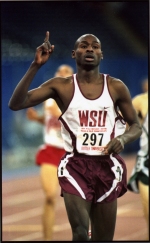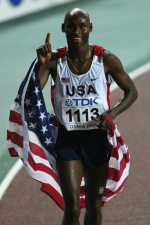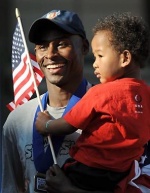Personal tools
Help
Tools
Class Notes
- Do you have news for fellow WSU alumni and other readers of Washington State Magazine? Send us your class note.
Our Story
written by alumni, faculty and friends.
NOTE: THIS IS A LEGACY SITE AND IS NOT REGULARLY MAINTAINED
Views
Difference between revisions of "Bernard Lagat comes home"
From Our Story
| Line 1: | Line 1: | ||
| − | From ''Washington State Magazine'', February 2008<br> | + | From ''Washington State Magazine'', February 2008<br> |
[[Image:Lagat family.jpg|thumb|left|300px]] | [[Image:Lagat family.jpg|thumb|left|300px]] | ||
| + | <br> | ||
| − | + | <br> | |
| − | |||
On his first morning back in Pullman, world track and field champion Bernard Lagat ’01 pulled on his running shoes and said a quick goodbye to his wife, Gladys Tom ’00, and son, Miika. | On his first morning back in Pullman, world track and field champion Bernard Lagat ’01 pulled on his running shoes and said a quick goodbye to his wife, Gladys Tom ’00, and son, Miika. | ||
| Line 13: | Line 13: | ||
After years of training in Arizona, Kenya, and, more recently, racing in Athens and Osaka, returning to his old jogging route was like visiting an old friend, says Lagat, who came to WSU in December to be publicly honored by the University’s athletic department. The two-lane country road brought back memories of a time when he knew he could be fast enough to compete against the world’s best, but was still preparing himself to do it. “I think I ran there more than anybody else,” says Lagat. “I used to drive there by myself four times a week.” | After years of training in Arizona, Kenya, and, more recently, racing in Athens and Osaka, returning to his old jogging route was like visiting an old friend, says Lagat, who came to WSU in December to be publicly honored by the University’s athletic department. The two-lane country road brought back memories of a time when he knew he could be fast enough to compete against the world’s best, but was still preparing himself to do it. “I think I ran there more than anybody else,” says Lagat. “I used to drive there by myself four times a week.” | ||
| − | On this frigid morning he made note of everything. “I remembered the landmarks for a mile, the second mile, the third mile,” he says. “It was really awesome being back there.” [[Image: | + | On this frigid morning he made note of everything. “I remembered the landmarks for a mile, the second mile, the third mile,” he says. “It was really awesome being back there.” [[Image:Wsu number 1.jpeg|thumb|right]] |
| − | The whole cross country team stuck with him for 10 miles of the run. Only one student made the extra loop, finishing the full 15-mile workout with Lagat, and chalking up a few memories of his own. | + | The whole cross country team stuck with him for 10 miles of the run. Only one student made the extra loop, finishing the full 15-mile workout with Lagat, and chalking up a few memories of his own. |
Lagat, who grew up in Kenya, had his choice of colleges. Harvard wanted him. So did Ole Miss and Fairleigh Dickenson in New Jersey. But the decision to come to WSU was easy. His running coach in Kenya knew coach James Li, and Eric Kamau, his training partner from Kenya, was here. “I felt really comfortable making my decision here,” says Lagat. “It suited me very well.” | Lagat, who grew up in Kenya, had his choice of colleges. Harvard wanted him. So did Ole Miss and Fairleigh Dickenson in New Jersey. But the decision to come to WSU was easy. His running coach in Kenya knew coach James Li, and Eric Kamau, his training partner from Kenya, was here. “I felt really comfortable making my decision here,” says Lagat. “It suited me very well.” | ||
| Line 23: | Line 23: | ||
“I got the best out of the place,” he says. In addition to pursuing a degree in management information systems, he became a key runner for both the cross country and track and field teams. “It is an amazing experience training in a place like Pullman,” he says. The hot weather, the cold weather, the snow and wind. “You might even feel depressed at some point, but it makes you so tough,” he says. | “I got the best out of the place,” he says. In addition to pursuing a degree in management information systems, he became a key runner for both the cross country and track and field teams. “It is an amazing experience training in a place like Pullman,” he says. The hot weather, the cold weather, the snow and wind. “You might even feel depressed at some point, but it makes you so tough,” he says. | ||
| − | Reminiscing at a reception in his honor at Beasley Coliseum, Lagat pauses to glance up at a video of one of his NCAA races. In it he’s yards ahead of everyone else, but keeps glancing back as he heads to the finish line. I ask him what he was thinking at the time. “I loved my teammates,” he says. “I knew I would win. I was looking back to check where they are. I was not tired. I was thinking, hey, I’m having fun.” | + | Reminiscing at a reception in his honor at Beasley Coliseum, Lagat pauses to glance up at a video of one of his NCAA races. In it he’s yards ahead of everyone else, but keeps glancing back as he heads to the finish line. I ask him what he was thinking at the time. “I loved my teammates,” he says. “I knew I would win. I was looking back to check where they are. I was not tired. I was thinking, hey, I’m having fun.” |
[[Image:With flag.jpeg|thumb|left]]During his NCAA racing career, his WSU coaches were asking him to run two, and sometimes three, events at a meet. Though he would have done his job with just one race, Lagat was often willing to compete in the 800-, 1500-, and 3000-meter races. “Part of being on a team is to contribute to the team to win,” he says. His contributions were recognized in 1999, when he was named Pac-10 athlete of the year. That doubling, and sometimes tripling, of events helps him even now to understand his limits and appreciate how one race can prepare him to go faster in another. | [[Image:With flag.jpeg|thumb|left]]During his NCAA racing career, his WSU coaches were asking him to run two, and sometimes three, events at a meet. Though he would have done his job with just one race, Lagat was often willing to compete in the 800-, 1500-, and 3000-meter races. “Part of being on a team is to contribute to the team to win,” he says. His contributions were recognized in 1999, when he was named Pac-10 athlete of the year. That doubling, and sometimes tripling, of events helps him even now to understand his limits and appreciate how one race can prepare him to go faster in another. | ||
Revision as of 17:41, February 20, 2009
From Washington State Magazine, February 2008
On his first morning back in Pullman, world track and field champion Bernard Lagat ’01 pulled on his running shoes and said a quick goodbye to his wife, Gladys Tom ’00, and son, Miika.
It was 8 a.m. and about 19 degrees outside. But the morning was clear, and there was plenty of Johnson Road to share with the 17-member Washington State University cross country team.
After years of training in Arizona, Kenya, and, more recently, racing in Athens and Osaka, returning to his old jogging route was like visiting an old friend, says Lagat, who came to WSU in December to be publicly honored by the University’s athletic department. The two-lane country road brought back memories of a time when he knew he could be fast enough to compete against the world’s best, but was still preparing himself to do it. “I think I ran there more than anybody else,” says Lagat. “I used to drive there by myself four times a week.”
On this frigid morning he made note of everything. “I remembered the landmarks for a mile, the second mile, the third mile,” he says. “It was really awesome being back there.”The whole cross country team stuck with him for 10 miles of the run. Only one student made the extra loop, finishing the full 15-mile workout with Lagat, and chalking up a few memories of his own.
Lagat, who grew up in Kenya, had his choice of colleges. Harvard wanted him. So did Ole Miss and Fairleigh Dickenson in New Jersey. But the decision to come to WSU was easy. His running coach in Kenya knew coach James Li, and Eric Kamau, his training partner from Kenya, was here. “I felt really comfortable making my decision here,” says Lagat. “It suited me very well.”
In 1996, before he left Kenya for WSU, he just missed a place on the Kenyan Olympic team by a whisker. It was the first time Lagat realized that he could be a world-class runner. “So when I came here, I was looking past college. My focus was the 2000 Olympics,” he says. Pullman was the place to train, learn, and prepare.
“I got the best out of the place,” he says. In addition to pursuing a degree in management information systems, he became a key runner for both the cross country and track and field teams. “It is an amazing experience training in a place like Pullman,” he says. The hot weather, the cold weather, the snow and wind. “You might even feel depressed at some point, but it makes you so tough,” he says.
Reminiscing at a reception in his honor at Beasley Coliseum, Lagat pauses to glance up at a video of one of his NCAA races. In it he’s yards ahead of everyone else, but keeps glancing back as he heads to the finish line. I ask him what he was thinking at the time. “I loved my teammates,” he says. “I knew I would win. I was looking back to check where they are. I was not tired. I was thinking, hey, I’m having fun.”
During his NCAA racing career, his WSU coaches were asking him to run two, and sometimes three, events at a meet. Though he would have done his job with just one race, Lagat was often willing to compete in the 800-, 1500-, and 3000-meter races. “Part of being on a team is to contribute to the team to win,” he says. His contributions were recognized in 1999, when he was named Pac-10 athlete of the year. That doubling, and sometimes tripling, of events helps him even now to understand his limits and appreciate how one race can prepare him to go faster in another.Though he left WSU in 2000 to compete in the Sydney Olympics for Kenya, he came back to finish his degree, a promise he made to his parents. And to start his life. He had long admired fellow student Gladys Tom, but while they were both student athletes she wouldn’t go against athletic department policy and date a fellow athlete. But once he was a pro runner, the rule was moot. “I waited a year and a half,” he says. “I had to understand. She was very professional about her athlete status.”
They had their first date at a Mandarin restaurant in Pullman, he says. It was followed by a few more at places like Pete’s and Denny’s. “You have to remember, we were students,” he says.While Tom earned her master’s degree in human nutrition, Lagat finished his business degree. Then he went on to race professionally. In 2004 he won an Olympic silver for Kenya. In 2005 he became a U.S. citizen, and last summer he won golds in the 1500 and the 5000 at the IAAF World Championships of Track and Field in Japan.
Lagat and Tom were married, and in 2006 welcomed Miika into their family. They now live in Arizona, where Lagat can train at high altitudes and be close to his coach, James Li.
Though he’s in full training for the 2008 Olympics in Beijing, he is also taking some time to travel and return to his roots. In the fall he brought his small family to Kenya to visit his parents. And this winter he stopped to visit his first American home, in Pullman. “It feels great to be back,” he says. “I have so many memories here.
Our Story site map
Our Story main page | Our Story categories | Help Desk
Contact | Give | Advertise
Washington State Magazine | Washington State University | Class Notes
Our Story is coordinated by
In partnership with
Our Story and Washington State Magazine are publications of Washington State University. All rights reserved.
P.O. Box 641227, Washington State University, Pullman, WA 99164-1227 USA | wsm@wsu.edu, 509-335-2388
Accessibility | Copyright | Policies




